신생아의 발육(신생아의 발달) Development in newborn infants
- 갓 태어나서 부터 18세까지의 기간을 소아청소년기 또는 소아기라고 한다.
- 그 기간 동안에 있는 신생아들, 영아들, 유아들, 학령기 아이들과 사춘기 아이들을 소아청소년들 또는 소아들이라고 한다.
- 소아들의 발육에 관해서 알아볼 때 소아청소년과학에서는 소아들의 발육을 신체 발육, 손 발육, 언어 발육과 사회성 발육 등으로 나눈다.
- 부모들이 자녀들을 양육할 때 자녀가 얼마나 잘 발육됐는지, 어느 정도로 발육 지연이 있는지 알아볼 수 있게 소아 발육에 관한 정보를 여기에서 제공하려고 한다.
- 여기에 있는 거의 모든 소아 발육에 관한 정보는 미 소아청소년과 학회에서 얻은 정보이다.
- 특히 소아 성장 발육학을 전공한 소아 성장 발육과 전문의는 소아 성장 발육에 더 많은 전문지식을 가지고 있다.
- 소아 성장 발육의 문제가 생길 때 때로는 소아 성장 발육과 전문의의 도움이 필요할 때도 있다는 것을 언급하고 싶다.
- 소아 발육에 관해서 다음 신체 발육, 손 발육, 언어 발육, 사회성 발육 각 항을 참조
| 신생아 신체 발육 |
Physical development in newborn infants
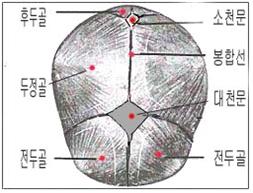
그림 2-19. 신생아의 두개골, 봉합, 대천문과 소천문
Copyright ⓒ 2012 John Sangwon Lee, MD., FAAP
- 갓 태어난 신생아의 머리 둘레는 가슴둘레보다 조금 더 큰 것이 보통이다.
- 갓 태어난 신생아의 몸통의 양쪽을 양손으로 붙들고 세워 앉히면 힘이 없어 목이 흔들거리는 것이 보통이다.
- 갓 태어난 신생아의 머리가 분만 중 산도에 눌려 몰딩(소형 또는 주형. 사진2-20~32 참조)이 생길 수 있고 그 머리통의 모양의 변화가 산후 며칠 동안 계속될 수 있다.
- 출생 후 하루 이틀 삼일 동안 머리통이 한쪽으로 일시적으로 삐뚤어질 수 있고 머리통이 앞뒤로 길어질 수도 있다.
- 분만 중 산도에 눌려 생긴 이런 종류의 머리통의 모양을 몰딩, 주형 또는 소형이라 한다([부모도 반의사가 되어야 한다-소아가정간호백과]- 제 6권 신생아 성장 발육 및 질병- 소형 참조).
- 산도에 눌려 생긴 불균형 머리통은 생후 2∼3일 내 본래 머리통의 모양으로 자연히 돌아가는 것이 보통이다.
- 갓 태어난 신생아의 머리통의 앞 부위 중앙에 한 개의 대천문이 있다. 대천문을 숨구멍이라고 한다.
- 신생아들의 대천문의 크기는 생후 2∼3개월 된 영아들의 대천문의 크기보다 때로는 더 작을 수 있다.
- 대천문은 생후 2∼3개월 이후부터 점점 더 작아지기 시작해서 생후 18∼24개월이 될 때까지 자연적으로 완전히 막히는 것이 정상적이다.
- 신생아들이나 영아들에게 생긴 어떤 병을 진단 검진할 때 이 대천문을 조심히 육안으로 살펴보면 거기서 임상적으로 중요한 정보를 얻을 수 있다.
- 갓 태어난 신생아들은 아주 작은 물체를 자세히 볼 수는 없지만 큼직한 물체를 볼 수 있는 시력을 가지고 있다.
- 갓 태어난 신생아들도 엄마 아빠의 얼굴을 쳐다볼 수 있고 엄마 아빠의 눈길 접촉 사랑을 받을 수 있다. 부모는 사랑스런 좋은 눈길로 많이 사랑 해줘야 한다.
- 생후 1∼2주 정도 되면 신생아들은 엄마 아빠가 웃는 얼굴을 확실히 알아볼 수 있다.
- 엄마 아빠가 웃으면 자기도 따라서 웃고 좋아한다.
- 찡그린 엄마 아빠의 얼굴을 알아보고 자기도 기분 나빠한다.
- 신생아도 이렇게 몸짓 말(신체 언어)로 부모와 대화를 하고 의사소통을 한다.
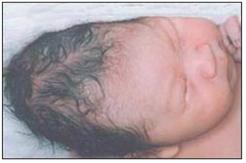
사진 2-20. 신생아의 몰딩(소형).
자연 분만 중 머리통이 이런 모양으로 길게 늘어나고 변형되는 것이 보통이다. 이것도 정상이다.
Copyright ⓒ 2012 John Sangwon Lee, MD., FAAP
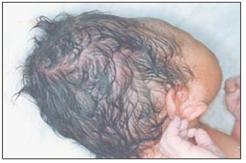
사진 2-21. 신생아의 몰딩(소형).
자연 분만 중 머리통이 길게 늘어나는 것이 보통이다.
Copyright ⓒ 2012 John Sangwon Lee, MD., FAAP
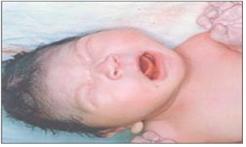
사진 2-22. 신생아의 몰딩.
산도 속을 통과할 때 머리가 이런 모양으로 일시적으로 길게 늘어나고 변형되는 것이 보통이다. 선단 청색증으로 양 손이 파랗다.
Copyright ⓒ 2012 John Sangwon Lee, MD ., FAAP
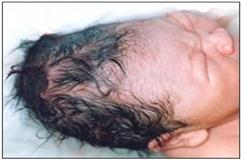
사진 2-23. 신생아의 몰딩.
산도를 통과해서 출생할 때 머리가 이런 모양으로 일시적으로 길게 늘어나고 변형되는 것이 보통이다.
Copyright ⓒ 2012 John Sangwon Lee, MD., FAAP
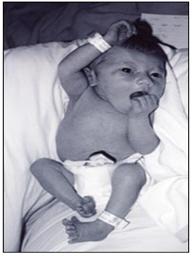
사진 2-24. 갓 태어난 신생아. 손가락을 빨고 있다.
Copyright ⓒ 2012 John Sangwon Lee, MD., FAAP
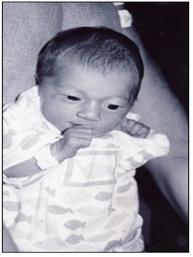
사진 2-25. 갓 태어난 신생아가 배가 고프지도 않는데 손을 빤다.
Copyright ⓒ 2012 John Sangwon Lee, MD., FAAP
| 신생아의 손과 발의 발육(신생아의 손과 발의 발달) |
Development of hands and feet in newborn infants
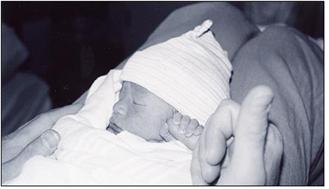
사진 2-26. 갓 태어난 신생아가 아빠의 손가락을 꼭 잡고 있다. 아빠가 아기를 무릎 위에 올려놓고 둘이서 신체적 접촉 사랑을 만끽하고 있다.
아기의 한 쪽 손의 크기가 아빠의 새끼손가락의 한 마디만큼 큰 것을 볼 수 있다.
Copyright ⓒ 2012 John Sangwon Lee, MD., FAAP

사진 2-27. 갓 태어난 신생아가 자기의 손을 아빠의 손바닥에 올려놓고, 둘이서 누구의 손이 더 큰가 비교하면서 신체적 접촉 사랑을 만끽하고 있다.
Copyright ⓒ 2012 John Sangwon Lee, MD., FAAP
- 신생아들의 손과 발은 거의가 불수의적으로 움직인다.
- 피 검사를 하기 위해 신생아의 한쪽 발에서 피를 뽑을 때가 있다. 피를 뽑는 사람이 한쪽 손으로 신생아의 왼쪽 발을 붙들고 그 쪽 발에서 피를 뽑을 때 그 신생아는 피를 뽑을 뽑히지 않는 바른 쪽 발로 피 뽑으려고 잡은 임상 검사원의 손을 차는 것을 볼 수 있다.
- 이런 실례를 보면, 신생아도 수의적으로 손발을 어느 정도로 움직이며 자위 행동을 취할 수 있는 것 같다.
- 건강한 모든 신생아에게 파악 반사가 있다.
- 파악 반사는 원시 반사이다.
- 신생아의 손바닥에다 엄마의 손가락이나 아빠의 손가락을 갖다 대면 신생아는 그 손을 꼭 붙잡고 쉽게 놓지 않는다.
- 이런 현상은 불수의적으로 생기는 정상적인 원시 반사이다.
- “파악 반사(Grasp reflex)”는 신생아가 엄마의 품에서 절대로 떨어지지 않고 매달리데 이용하는 반사인 것 같다.
- 엄마의 품에서 떨어져 나가지 않겠다고 엄마에게 알리는 몸짓 말이라고 생각한다.
- 파악 반사는 태어난 이후 바로 나타나고 생후 3∼4개월경 자연히 없어진다.
- 생후 3∼4 개월 전후 영아들은 손을 어느 정도 수의적으로 움직일 수 있다.
- 태어난 이후부터 신생아 발에 “걷는 반사”가 나타난다.

사진 2-28. 신생아가 손을 입에 물고 잔다.
Copyright ⓒ 2012 John Sangwon Lee, MD ., FAAP

사진 2-29. 갓 난 신생아가 엄마의 손가락을 잡고 있다
이런 현상은 파악 반사로 생긴다. 일종의 원시 반사이다.
Copyright ⓒ 2012 John Sangwon Lee, MD., FAAP
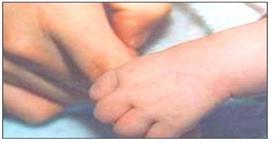
사진 2-30. 2주 된 신생아가 엄마의 손가락을 꼭 잡고 있다.
Copyright ⓒ 2012 John Sangwon Lee, MD., FAAP
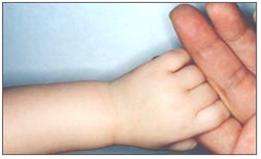
사진 2-31. 신생아가 손으로 엄마의 손을 꼭 잡고 있다. 아기 손에 몽고반점이 나 있다.
Copyright ⓒ 2012 John Sangwon Lee, MD., FAAP
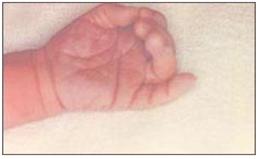
사진 2-32. 갓 난 아기의 예쁜 손.
Copyright ⓒ 2012 John Sangwon Lee, MD., FAAP

사진 2-33. 신생아의 정상 아랫다리와 발,
생리적 ○형 다리.
Copyright ⓒ 2012 John Sangwon Lee, MD., FAAP
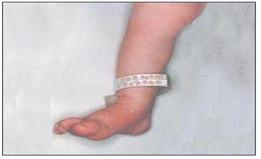
사진 2-34. 신생아의 정상 아랫다리와 발.
Copyright ⓒ 2012 John Sangwon Lee, MD, FAAP
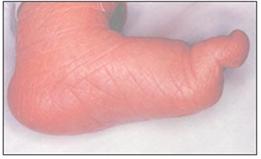
사진 2-35. 신생아의 정상 발
대부분의 신생아들의 발바닥은 정상적으로 편평하다. 뚜렷한 발바닥 아치가 정상적으로 생겨 있지 않다.
이런 발바닥을 “생리적 편평족“이라 한다.
Copyright ⓒ 2012 John Sangwon Lee, MD/, FAAP
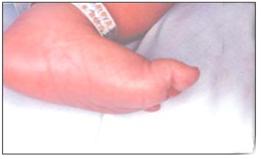
사진 2-36. 신생아의 정상 발
대부분의 신생아들의 발바닥은 정상적으로 편평하다. 이런 발바닥을 “생리적 편평족“이라 한다.
자연이 치료된다.
Copyright ⓒ 2012 John Sangwon Lee, MD ., FAAP
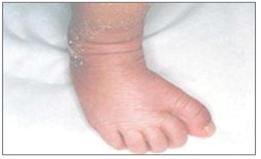
사진 2-37. 신생아의 정상 발
발의 표피가 살짝 조금 벗겨지는 것은 거의가 정상이다. 신생아의 발에 생리적 내반이 생겨 있다. 이것도 정상일 수 읻.
Copyright ⓒ 2012 John Sangwon Lee, MD., FAAP
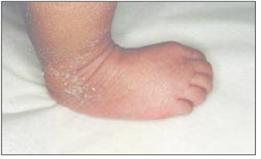
사진 2-38. 신생아의 정상 발
신생아의 발에 “생리적 내반“이 생겨 있다. 발의 피부가 살짝 조금 벗겨지는 것은 대개 정상이다.
Copyright ⓒ 2012 John Sangwon Lee, MD., FAAP
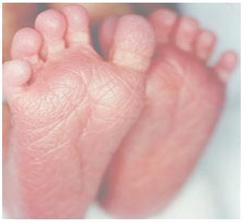
사진 2-39.신생아의 정상 두 발.
방바닥이 정상적으로 평편하다.
Copyright ⓒ 2012 John Sangwon Lee, MD., FAAP
| 신생아의 생리적 체중 감소 |
Neonatal physiologic weight loss
- 태아는 태어나기 전까지 자궁 내 양수에 잠겨서 자란다.
- 출생 직후 신생아의 전신을 푹신 적셨던 양수가 마르고, 태어나기 전 자궁 속에서 배설하지 않은 소변과 태변을 눈다.
- 그래서 출생 직후 체중이 급격히 감소한다.
- 모유를 먹는 신생아 대부분은 생후 첫 2∼3일까지 초유와 전이 모유(이행성 모유)를 조금 먹고 그 다음 성숙 모유를 먹는다. 인공영양을 먹는 신생아도 생후 첫 2∼3일까지 충분히 섭취하지 않는다.
- 거의 모든 신생아의 체중은 생후 2∼7일까지 자연적으로 다소 감소한다. 그래서 생후 2∼7일 동안 신생아의 체중이 출생 시 체중의 6∼10% 정도 감소될 수 있다. 이런 체중 감소를 신생아의 생리적 체중 감소라고 한다.
- 신생아의 생리적 체중 감소로 줄어든 신생아 체중은 적어도 생후 7∼14일까지 출생 시의 체중과 거의 같거나 그 이상으로 증가되고 그 후부터 1일 평균 15∼20g 정도 계속 증가한다.
- 신생아의 생리적 체중 감소로 출생 시 체중의 6∼10%가 줄어든 후 신생아 체중이 생후 7∼14일까지 정상적으로 증가되지 않으면, 신생아가 모유나 인공영양을 충분히 먹고 있는지, 수유 방법이 잘못되어 있는지, 어떤 병을 앓고 있는지, 또는 다른 이유로 체중이 증가하지 않는지 알아보아야 한다.
- 신생아의 체중이 정상적으로 증가하지 않으면, 의사에게 곧 문의해 정확한 원인을 알아내야 한다.

사진2-15. 신생아의 체중은 생후 2~7일까지 출생체중의 6∼10% 정도 감소한다. 생후 7∼14일까지 출생체중과 거의 같게 다시 증가한다.
| 한국 신생아의 체중 및 신장의 성장차트와 백분위수 |
(Weight and height charts and percentile of Korean newborn infants)
- 자녀를 기르는 동안, 성장하고 있는 “어린 자녀가 너무 크다” 또는 “너무 작다”고 걱정하는 부모들이 많다. 그
- 런 걱정을 하기 전에 자녀의 체중과 신장을 측정하여 체중 치와 신장 치를 성장차트 체중·신장 백분위선 중 체중과 신장이 어디에 속하는지 알아보면, 자녀의 성장 패턴을 쉽게 이해할 수 있고, 자녀의 성장에 관해 더 과학적이고 쉽게 이해할 수 있다.
- 예를 들면, 갓 태어난 남자 신생아의 출생 시 체중이 2.6㎏일 때 체중치를 성장차트 체중 백분위선 중 신생아의 체중이 3 백분위수에 속하는 것을 알 수 있다.
- “남자 신생아의 체중이 3 백분위수에 속 한다”는 것은, 통계학적으로 그 신생아와 나이·성별·종족이 같은 남자 신생아 1백 명 중 2명의 신생아의 체중이 그 신생아의 체중(2.6㎏)보다 가볍고, 97명의 신생아의 체중은 그 신생아의 체중보다 더 무겁다는 뜻이다.
표 2-2.한국 신생아의 체중 및 신장의 백분위수( 퍼센타일)
|
백분위 수 성별 |
3 | 10 | 25 | 50 | 75 | 90 | 97 | |
| 남아 | 체중(Kg) | 2.60 | 2.80 | 3.09 | 3.31 | 3.60 | 3.90 | 4.10 |
| 남아신장(cm) | 46.0 | 48.0 | 50.0 | 51.0 | 53.0 | 54.0 | 56.0 | |
| 여아 | 체중(Kg) | 2.60 | 2.76 | 3.00 | 3.20 | 3.50 | 3.80 | 41.0 |
| 여아신장(cm) | 47.0 | 48.0 | 49.0 | 50.4 | 52.0 | 54.0 | 55.0 |
- 또 다른 예를 들면, 어떤 남자 신생아의 출생 시 체중이 4.1㎏일 때 체중을 성장차트 체중·신장 백분위선 중 그 신생아의 체중이 97 백분위수에 속한다는 것을 알 수 있고, 또래 신생아들 중 어느 정도로 체중이 무거운지 쉽게 알 수 있다.
- 이 경우에, “남자 신생아의 출생 시 체중이 97 백분위수에 속한다”는 것은 그 신생아의 나이·성별·종족과 같은 남자 신생아들 1백 명 중 2명의 신생아의 출생 시 체중은 그 남아 신생아의 체중 (4.1㎏) 보다 무겁고, 96명의 신생아 출생 시 체중은 그 남아 신생아의 출생 시 체중보다 가볍다는 것을 뜻한다.
- 각 아이의 성장·발육 속도는 유전·체질·환경 등의 여러 조건에 따라 많이 다르다.
- 따라서 내 아이의 체중과 신장의 성장·발육 정도를 다른 아이들의 체중과 신장의 발육 정도와 비교하는 것보다, 내 아이의 체중 치와 신장 치를 성장차트 체중·신장 백분위선에 따라 정상적으로 계속 늘어나고 있는지 알아보는 것이 더 중요하다.
- 다시 설명하면, 다른 아이의 성장과 내 아이의 성장을 비교해 볼 수는 있지만, 내 아이의 성장이 내 아이의 성장차트 체중·신장 백분위선을 따라 자라고 있는지 알아보는 것이 더 의미가 있다.
- 어떤 아이의 체중과 신장이 그 아이의 성장차트 체중·신장 백분위선에 따라 이전과 같이 계속 늘어나면, 그 아이는 정상적으로 성장하고 있다고 볼 수 있다.
- 아이의 체중 치와 신장 치는 이전 성장 차트 체중·신장 백분위선 따라 계속 증가하지 않고 조금 더 위에 있거나 조금 더 아래에 있는 백분위선을 따라 증가하는 일 반 적이다.
- 아이의 체중 치와 신장 치를 성장 차트에 표시했을 때, 아이의 체중과 신장이 이전의 체중과 신장의 백분위선을 따라 계속 늘어나지 않고 체중이나 신장의 백분위선보다 훨씬 위에 있거나 훨씬 아래에 있는 백분위선을 따라 증가하거나, 몇 달 또는 몇 년 후에 측정한 체중이나 신장이 이전의 체중·신장 백분위수선을 따라 계속 증가하지 않으면, 아이의 성장에 어떤 이상이 있는지 알아보아야 한다. (부모도 반의사가 되어야 한다 -소아가정간호백과 -제 14권 소아 내분비선 질환. 성장차트와 백분위수 참조).
| 신생아의 언어 발육(신생아의 언어 발달) |
Language development in newborn infants
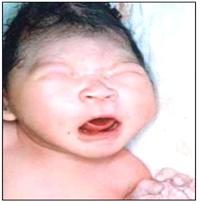
사진 2-40. 갓 태어난 신생아가 아앙 운다. 울음은 아기의 언어이다. 아기의 울음소리에 음색이 있다. 각 울음소리의 음파 톤에 차이가 있다.
Copyright ⓒ 2012 John Sangwon Lee, MD., FAAP
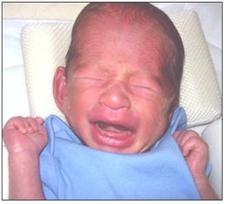
사진 2-41. 신생아가 운다.
아기의 울음은 즐겁다든지, 춥다든지 덥다든지, 배고프다든지, 아프다든지 등 자신의 요구나 감정을 표시할 때 쓰는 아기의 언어이다.
이 울음과 몸짓 말(Body language)로 서로 대화할 때 쓴다.
Copyright ⓒ 2012 John Sangwon Lee, MD., FAAP
- 신생아들의 울음은 대화를 할 때 쓰는 만국 공통 언어이고 말이다.
- 그들은 몸짓 말로 신체 말로 대화를 한다.
- 그들이 대화를 할 때 의사소통을 하는 수단으로 울음을 이용한다.
- 엄마아빠는 아기의 울음 말과 몸짓 말을 잘 관찰하고 보고 들으면 그들이 요구하는 것이 무엇인지 곧 파악할 수 있다.
- 신생아들이 우는 원인에는 여러 가지가 있다.
- 마치 신생아기 이후 영유아기 아기들이 자기의 의사를 언어로 몸짓 말로 눈으로 표현하듯이 신생아들도 기쁨, 슬픔, 아픔, 배고픔, 덥고 추운 것을 울음 말로, 또는 몸짓 말로 표현한다.
- 신생아들이 울 때 눈물이 눈물샘에서 분비되어 안구로 흘러나온다.
- 그러나 뺨으로 흘러나올 정도로 눈물이 많이 나지 않는 것이 보통이다.
- 성인들이나 큰 아이들이 말할 때 눈물이 나지 않듯이 신생아가 울 때, 즉 울음 말을 할 때 뺨으로 눈물이 흘러나오지 않는다.
- 이런 현상을 살펴보면, 대부분의 경우, 신생아의 울음은 말이란 것을 알 수 있다.
- 엄마 아빠는 갓 태어난 신생아를 포근히 안아 신체적 접촉사랑을 많이 해 주고, 낮고 부드럽고 점잖고 사랑스런 말을 많이많이 해 주면서 눈길접촉으로 사랑해야 한다.
- 이때부터 아기 자녀와 엄마아빠가 서로 말을 주고받으면서 대화를 하기 시작한다.
- 엄마아빠는 부드럽고 사랑스러운 좋은 말을 많이 해서 바른 길로 가도록 가르치기 시작한다.
- 부모는 옳은 말만 하고 거짓말은 해서는 안 된다. 대화를 하는 동안 서로 눈길 접촉 사랑을 나눈다.
- 이렇게 해야 엄마아빠 자식 간 사랑 반딩(Love bonding)이 굳건히 형성된다.
Development in newborn infants
• The period from birth to 18 years of age is called adolescence or childhood.
• Newborns, infants, toddlers, school-age children and adolescents during that period are called juveniles or children.
• When it comes to children’s development, pediatric and adolescent science divides children’s development into physical development, hand development, language development and social development.
• We are here to provide information on child development so that parents can see how well their child is developing and the extent to which there is a delay in raising their child.
• Almost all pediatric developmental information presented here is from the American Academy of Pediatrics.
• In particular, pediatric growth and development specialists who majored in pediatric growth and development have more expertise in child growth and development.
• I would like to mention that sometimes you need the help of a pediatric growth and development specialist when you have a child growth and development problem.
• Regarding child development, refer to the following sections on physical development, hand development, language development, and social development. newborn body development Physical development in newborn infants

Figure 2-19. Neonatal skull, sutures, and grand and small Copyright ⓒ 2012 John Sangwon Lee, MD., FAAP
• The head circumference of a newborn baby is usually slightly larger than the chest circumference.
• If you hold both sides of a newborn baby’s torso with both hands and sit upright, it is common for the neck to shake due to lack of strength.
• A newborn baby’s head may be pressed against the birth canal during delivery, resulting in molding (small or molded; see photos 2-20-32) and the change in the shape of the head may continue for several days after childbirth.
• For a day, two or three days after birth, the head may be temporarily crooked to one side and the head may be elongated back and forth.
• The shape of this type of head that is pressed into the birth canal during labor is called a molding, mold or miniature (see www.drleepediatrics.cm – Volume 6 Neonatal Growth and Development and Diseases – Small).
• It is normal for an unbalanced headache caused by pressure on the birth canal to return to its original shape within 2 to 3 days after birth.
• There is a single arch in the center of the anterior part of the head of a newborn newborn.
The Great Heavenly Gate is called the breath hole.
• The size of the grand astronomical gates of newborns can sometimes be smaller than the size of the large astronomical gates of infants aged 2-3 months.
• The large astronomy starts to get smaller after 2-3 months of age, and it is normal to completely block it naturally until 18-24 months of age.
• A careful visual examination of this grand astronomical observatory when diagnosing any disease in newborns or infants can provide clinically important information.
• Newborns cannot see very small objects in detail, but they have the ability to see large objects.
• Newborns can also look into mom and dad’s faces and receive the love of her mom and dad’s eye contact. Parents should give a lot of love with loving kind eyes.
• Around 1 to 2 weeks old, newborns can clearly recognize the smiling faces of their mothers and fathers.
• When mom and dad laugh, she likes to laugh too.
• Recognizes the grimacing faces of Mom and Dad and makes her feel bad too. • Newborns also communicate and communicate with their parents using body language (body language).

Photo 2-20. Newborn moldings (small). During natural childbirth, it is normal for the head to be elongated and deformed in this shape. This is also normal. Copyright ⓒ 2012 John Sangwon Lee, MD., FAAP

Picture 2-21. Newborn moldings (small). It is normal for the hair to grow longer during natural childbirth. Copyright ⓒ 2012 John Sangwon Lee, MD., FAAP

Picture 2-22. Newborn’s molding. It is normal for the head to temporarily elongate and deform into this shape as it passes through the birth canal. Both hands are blue due to apical cyanosis. Copyright ⓒ 2012 John Sangwon Lee, MD ., FAAP

Picture 2-23. Newborn’s molding. It is normal for the head to temporarily elongate and deform into this shape at birth through the birth canal. Copyright ⓒ 2012 John Sangwon Lee, MD., FAAP

Picture 2-24. newborn newborn. sucking your finger Copyright ⓒ 2012 John Sangwon Lee, MD., FAAP

Photo 2-25. A newborn baby sucks his hand even though he’s not hungry. Copyright ⓒ 2012 John Sangwon Lee, MD., FAAP
Development of hands and feet in newborns (development of hands and feet in newborns)
Development of hands and feet in newborn infants

Picture 2-26. A newborn baby is holding her dad’s finger. The father puts the baby on his lap and the two of them are enjoying the physical contact love. You can see that the size of one hand of the baby is as big as the size of a finger of the little finger of the father. Copyright ⓒ 2012 John Sangwon Lee, MD., FAAP

Picture 2-27. A newborn baby rests her baby’s hand on her dad’s palm, savoring the love of her physical touch as the two compare which hand is larger. Copyright ⓒ 2012 John Sangwon Lee, MD., FAAP
• Newborns’ hands and feet move almost involuntarily.
• Blood is sometimes drawn from one of the newborn’s feet for a blood test. When the drawer holds the newborn’s left foot with one hand and draws blood from that side, the newborn can be seen kicking the hand of the clinical examiner who is holding the blood draw with the right foot on which the blood is not drawn.
• Based on these examples, it seems that even a newborn baby can voluntarily move her limbs to some extent and engage in masturbation.
• All healthy newborns have a grasping reflex.
• The grasp reflex is a primitive reflex.
• If you put her mother’s finger or her father’s finger on a newborn’s palm, the newborn grasps the hand tightly and does not let go easily.
• These are normal primitive reflexes that occur involuntarily.
• The “Grasp reflex” seems to be the reflex a newborn uses to hang and never fall from her mother’s arms.
• She thinks it’s a gesture she tells her that she won’t fall out of her arms.
• The grasp reflex appears immediately after birth and disappears spontaneously around 3 to 4 months of age.
• Around 3-4 months of age, infants are able to move their hands to some degree voluntarily.
• A “walking reflex” appears on the feet of newborns from birth.

Picture 2-28. A newborn baby sleeps with her hand in her mouth. Copyright ⓒ 2012 John Sangwon Lee, MD ., FAAP

Picture 2-29. The newborn baby is holding her mom’s finger This phenomenon is caused by the grasp reflex. It is a kind of primitive reflection. Copyright ⓒ 2012 John Sangwon Lee, MD., FAAP

Photo 2-30. A 2-week old newborn is holding her mom’s finger. Copyright ⓒ 2012 John Sangwon Lee, MD., FAAP

Photo 2-31. A newborn baby is holding her mom’s hand with her hand. Her baby has Mongolian spots on her hands. Copyright ⓒ 2012 John Sangwon Lee, MD., FAAP

Photo 2-32. The pretty hands of a newborn baby. Copyright ⓒ 2012 John Sangwon Lee, MD., FAAP

Photo 2-33. Normal lower legs and feet of newborns, Physiological type ○ leg. Copyright ⓒ 2012 John Sangwon Lee, MD., FAAP

Photo 2-34. Normal lower legs and feet of a newborn. Copyright ⓒ 2012 John Sangwon Lee, MD, FAAP

Photo 2-35. normal feet of a newborn The soles of most newborns are normally flat. A distinct plantar arch is not normally formed. Such soles are called “physiological flatfoot”. Copyright ⓒ 2012 John Sangwon Lee, MD/, FAAP

Photo 2-36. normal feet of a newborn The soles of most newborns are normally flat. Such soles are called “physiological flat foot”. Nature heals. Copyright ⓒ 2012 John Sangwon Lee, MD ., FAAP

Photo 2-37. normal feet of a newborn A slight peeling of the epidermis of the feet is almost normal. There is a physiological varus in the foot of a newborn. This may also be normal. Copyright ⓒ 2012 John Sangwon Lee, MD., FAAP

Photo 2-38. normal feet of a newborn A “physiological varus” develop on the feet of newborns. A slight peeling of the skin on the feet is usually normal. Copyright ⓒ 2012 John Sangwon Lee, MD., FAAP

Photo 2-39.Normal two feet of a newborn. The floor is normally flat. Copyright ⓒ 2012 John Sangwon Lee, MD., FAAP
Physiological weight loss in newborns
Neonatal physiologic weight loss
• The fetus is immersed in amniotic fluid in the womb until it is born.
• Immediately after birth, the amniotic fluid that moistened the whole body of a newborn dries up, and urine and meconium that were not excreted in the womb before birth are removed.
• So you lose weight rapidly right after birth.
• Most breastfed newborns consume a small amount of colostrum and transfer milk (transitional milk) for the first 2 to 3 days of life and then feed on mature breast milk. Even newborns taking artificial nutrition do not consume enough until the first 2-3 days of life.
• Almost all newborns lose some weight naturally by the 2nd to 7th day of life. Thus, during the first 2 to 7 days of life, the newborn’s weight can be reduced by 6 to 10% of its birth weight. This weight loss is called the physiological weight loss of the newborn. • The weight of a newborn baby, which has been reduced due to the physiological weight loss of a newborn, increases to at least the same as or more than that at birth until at least the 7th to 14th day after birth, and then continues to increase by an average of 15-20g per day.
• If the newborn’s weight does not increase normally by 7-14 days after losing 6-10% of the birth weight due to the physiological weight loss of the newborn, whether the newborn is receiving enough breast milk or artificial nutrition, the wrong feeding method, You need to find out if you have an illness or if you are not gaining weight for any other reason.
• If your newborn does not gain weight normally, you should contact your doctor right away to determine the exact cause.

Picture 2-15. Newborns lose 6-10% of their birth weight by 2-7 days after birth. From the 7th to the 14th day after birth, it increases again, almost equal to the birth weight.
Growth charts and percentiles of weight and height of Korean newborns (Weight and height charts and percentile of Korean newborn infants)
• While raising children, many parents worry that their growing “younger is too big” or “too small”. That
• Before worrying about running, measure your child’s weight and height and find out where the weight and height belong to the weight and height percentiles of the growth chart, so you can easily understand your child’s growth pattern and grow your child’s growth. more scientific and easier to understand.
• For example, when a newborn male newborn weighs 2.6 kg at birth, it can be seen that the newborn’s weight is in the 3rd percentile of the weight percentiles of the growth chart.
• “The weight of a male newborn is in the 3rd percentile” means that the weight of 2 out of 100 male newborns of the same age, sex, and race as the newborn is statistically the weight of the newborn (2.6 kg). It is lighter, meaning that 97 newborns weigh more than newborns.
Table 2-2. Percentiles (Percentiles) of Weight and Height of Korean Newborns percentile
표 2-2.한국 신생아의 체중 및 신장의 백분위수( 퍼센타일)
|
percentile Gender |
3 | 10 | 25 | 50 | 75 | 90 | 97 | |
| Boy | weight (Kg) | 2.60 | 2.80 | 3.09 | 3.31 | 3.60 | 3.90 | 4.10 |
| Height (cm) | 46.0 | 48.0 | 50.0 | 51.0 | 53.0 | 54.0 | 56.0 | |
| girl | weight (Kg) | 2.60 | 2.76 | 3.00 | 3.20 | 3.50 | 3.80 | 41.0 |
| Height(cm) | 47.0 | 48.0 | 49.0 | 50.4 | 52.0 | 54.0 | 55.0 |
• As another example, when a newborn male newborn weighs 4.1 kg, it can be seen that the newborn’s weight is in the 97th percentile among the weight and height percentiles of the growth chart. You can easily tell how heavy it is.
• In this case, “the birth weight of a male newborn is in the 97th percentile” means that the birth weight of 2 out of 100 male newborns is that of the male newborn, such as the age, sex, and race of the newborn. It is heavier than body weight (4.1 kg), meaning that the birth weight of 96 newborns is lighter than the birth weight of the male newborn.
• The growth and development rate of each child varies greatly depending on various conditions such as genetics, constitution, and environment.
• Therefore, rather than comparing the growth and development of my child’s weight and height with the weight and height of other children, check whether my child’s weight and height are continuously increasing according to the growth chart weight and height percentile. It is more important to find out
• In other words, you can compare the growth of other children with your child’s growth, but it is more meaningful to see if your child’s growth is growing along with the weight and height percentiles of your child’s growth chart.
• If a child’s weight and height continue to increase as before according to the child’s growth chart weight and height percentile, it can be considered that the child is growing normally.
• A child’s weight and height values do not continue to increase according to the weight and height percentiles of the previous growth chart, but rather increase along with the upper or lower percentiles.
• When a child’s weight and height values are plotted on a growth chart, the child’s weight and height do not continue to increase along with the previous weight and height percentiles, but rather a percentile that is well above or well below the weight or height percentile. If the weight or height measured after several months or years does not continue to increase along with the previous weight/height percentile, it is necessary to determine if there is any abnormality in the child’s growth.
www.drleepediatrics.com – Vol. 14 Pediatric Endocrine Diseases. See growth charts and percentiles). Speech development in newborns (language development in newborns) Language development in newborn infants

Photo 2-40. A newborn baby cries. Crying is a baby’s language. There is a tone in the cry of a baby. There is a difference in the sonic tone of each cry. Copyright ⓒ 2012 John Sangwon Lee, MD., FAAP

Picture 2-41. Newborn crying. A baby’s cry is the baby’s language used to express his or her needs or emotions, such as being happy, cold or hot, hungry or sick. We use this cry and body language to communicate with each other. Copyright ⓒ 2012 John Sangwon Lee, MD., FAAP
• Crying of newborns is a universal language used for conversation. • They communicate with body language by body language.
• They use crying as a means of communication when they have a conversation.
• Mom and Dad can observe, see, and hear the baby’s cries and body language to quickly figure out what they are asking for.
• There are many reasons why newborns cry.
• Just as babies after newborn babies express their intentions through language and body language, newborns express joy, sadness, pain, hunger, hot and cold through crying or body language.
• When newborns cry, tears are released from the lacrimal glands and flow into the eyes.
• However, it is not uncommon for the tears do not to flow down to the cheeks. • Tears do not flow down the cheeks when a newborn cry, i.e., cries, just as adults and older children do not cry when they speak.
• Looking at this phenomenon, it can be seen that, in most cases, the cry of a newborn is a speech.
• Mom and Dad should hug the newborn baby and give her a lot of physical touch love, and give her lots of soft, gentle and loving words, and love with eye contact.
• From this point on, the baby and the mother and father start talking to each other.
• Mom and Dad start teaching her on the right path by saying a lot of nice, gentle, lovely things.
• Parents should only tell the truth and not lie. Make eye contact with each other while talking.
• Only in this way, love bonding between mother and father will be firmly formed.
출처 및 참조문헌
- www.drleepediatrics.com 제1권 소아청소년 응급 의료
- www.drleepediatrics.com 제2권 소아청소년 예방
- www.drleepediatrics.com 제3권 소아청소년 성장 발육 육아
- www.drleepediatrics.com 제4권 모유,모유수유, 이유
- www.drleepediatrics.com 제5권 인공영양, 우유, 이유식, 비타민, 미네랄, 단백질, 탄수화물, 지방
- www.drleepediatrics.com 제6권 신생아 성장 발육 육아 질병
- www.drleepediatrics.com제7권 소아청소년 감염병
- www.drleepediatrics.com제8권 소아청소년 호흡기 질환
- www.drleepediatrics.com제9권 소아청소년 소화기 질환
- www.drleepediatrics.com제10권. 소아청소년 신장 비뇨 생식기 질환
- www.drleepediatrics.com제11권. 소아청소년 심장 혈관계 질환
- www.drleepediatrics.com제12권. 소아청소년 신경 정신 질환, 행동 수면 문제
- www.drleepediatrics.com제13권. 소아청소년 혈액, 림프, 종양 질환
- www.drleepediatrics.com제14권. 소아청소년 내분비, 유전, 염색체, 대사, 희귀병
- www.drleepediatrics.com제15권. 소아청소년 알레르기, 자가 면역질환
- www.drleepediatrics.com제16권. 소아청소년 정형외과 질환
- www.drleepediatrics.com제17권. 소아청소년 피부 질환
- www.drleepediatrics.com제18권. 소아청소년 이비인후(귀 코 인두 후두) 질환
- www.drleepediatrics.com제19권. 소아청소년 안과 (눈)질환
- www.drleepediatrics.com 제20권 소아청소년 이 (치아)질환
- www.drleepediatrics.com 제21권 소아청소년 가정 학교 간호
- www.drleepediatrics.com 제22권 아들 딸 이렇게 사랑해 키우세요
- www.drleepediatrics.com 제23권 사춘기 아이들의 성장 발육 질병
- www.drleepediatrics.com 제24권 소아청소년 성교육
- www.drleepediatrics.com 제25권 임신, 분만, 출산, 신생아 돌보기
- Red book 29th-31st edition 2021
- Nelson Text Book of Pediatrics 19th- 21st Edition
- The Johns Hopkins Hospital, The Harriet Lane Handbook, 22nd edition
- 응급환자관리 정담미디어
-
소아가정간호백과–부모도 반의사가 되어야 한다, 이상원
-
Neonatal Resuscitation American heart Association
-
Neonatology Jeffrey J.Pomerance, C. Joan Richardson
-
Pediatric Resuscitation Pediatric Clinics of North America, Stephen M. Schexnayder, M.D.
-
Pediatric Critical Care, Pediatric Clinics of North America, James P. Orlowski, M.D.
-
Preparation for Birth. Beverly Savage and Dianna Smith
-
Infectious disease of children, Saul Krugman, Samuel L Katz, Ann A. Gershon, Catherine Wilfert
- 소아과학 대한교과서
- Other
Copyright ⓒ 2015 John Sangwon Lee, MD., FAAP
“부모도 반의사가 되어야 한다”-내용은 여러분들의 의사로부터 얻은 정보와 진료를 대신할 수 없습니다.
“The information contained in this publication should not be used as a substitute for the medical care and advice of your doctor. There may be variations in treatment that your doctor may recommend based on individual facts and circumstances. “Parental education is the best medicine.”